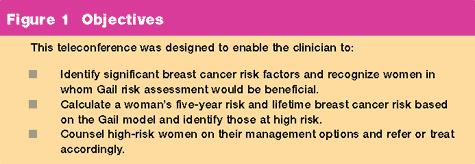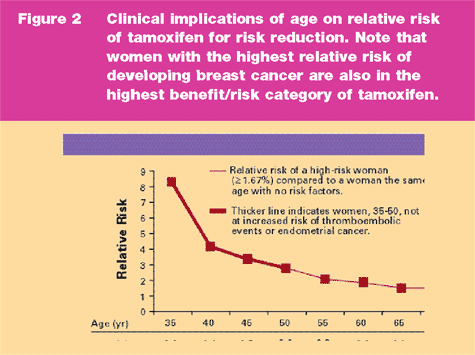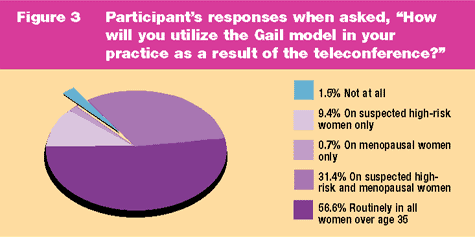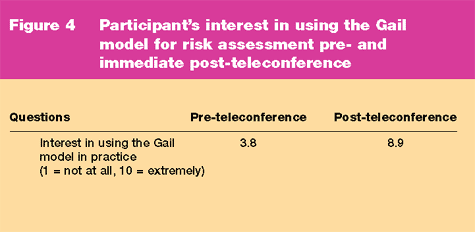 Home:
Meeting
Highlights: Posters
Home:
Meeting
Highlights: Posters

Breast Cancer Risk Assesment in the Primary Care Setting
Breast
Cancer Risk Assesment in the Primary Care Setting: A Pilot Teleconference
/ E-mail Program Targeting Gynecologists, Nurse Practitioners and
Physicians Assistants
Sally Bogert, NP; Michelle Finklestein, MD, Elena Cyrus, BA; Jennifer
Motley, MD; Neil Love, MD
Publication
of the Breast Cancer Prevention Trial (NSABP P-1) created a clinical
and perhaps medical-legal imprimatur for primary care clinicians
to identify women at increased risk for breast cancer and counsel
them regarding options. The P-1 study used the highly predictive
Gail model to identify women at increased risk, and although this
model is widely available for healthcare clinicians, it is not commonly
used. In addition, once a high-risk patient is identified, many
primary care clinicians refer these women to specialists rather
than counsel them and offer options such as chemoprevention or referral
to the NSABP's STAR trial (Study of Tamoxifen and Raloxifene).
As a result,
it is a public healthcare challenge to educate primary care providers
regarding the calculation of a woman's breast cancer risk and appropriate
management. Gynecologists, nurse practitioners (NP) and physician
assistants (PA) were targeted for a pilot educational program to
develop a method to facilitate the incorporation of this strategy
into clinical practice.
| Phase
I: Development of an educational content strategy |
Primary care
clinicians are inundated with educational and promotional materials
recommending a variety of preventive strategies that require time
to implement. To increase the likelihood of breast cancer risk assessment
receiving a high priority for the clinician's time, we assessed
how this strategy could meet other existing clinical needs in women's
health care. To do this, workshops using interactive keypad polling
were conducted at five continuing medical education programs for
gynecologists. The P-1 data and Gail model risk assessment tools
were reviewed, and clinicians were queried about the potential role
these might play in clinical practice. Following the meetings, e-mail
correspondence took place with these physicians and others who were
recruited to the project. Over 150 physicians provided input on
an ongoing basis as did a panel of breast cancer researchers who
were consulted on this project. Our goal was to determine how Gail
model risk assessment and counseling of high-risk women could be
effectively incorporated into primary women's health care, meeting
both the needs of patients and busy clinicians. As we developed
ideas, we transmitted these to clinicians by e-mail, who evaluated
the concepts in their practice and reported back to us.
The conclusions
of this initiative were as follows:
1.
The most useful aspect of Gail model assessment was in counseling
regarding the use of estrogen replacement therapy (ERT) in normal
risk menopausal women.
Clinicians uniformly
agreed that the greatest concern for women considering ERT was a
potential increased risk of breast cancer, and related discussions
were perceived by clinicians as challenging and time-consuming.
The Gail assessment was seen as very valuable in reassuring women
that their baseline risk of breast cancer was lower than the patients
(and clinicians) had believed, and this assisted clinicians in educating
women about the risks and benefits of ERT.
Clinicians preferred
a hand-held calculator compared to the computer disk or slide rule.
2.
Women at increased risk of breast cancer based solely on their age
were not deemed appropriate candidates for Gail assessment or referral
to the STAR trial.
While the NSABP
accepted these women into P-1 based on an increased five-year risk,
clinicians generally believed that breast cancer was not a key preventive
issue for these women (mainly over age 65), particularly compared
to other issues such as heart disease and osteoporosis. While clinicians
were concerned about medical-legal implications of not identifying
and informing high-risk women about their options, it was widely
believed that for a woman to be considered "high-risk,"
she must have had a prior breast biopsy or a first-degree relative
with breast cancer.
A strategy supported
by clinicians that encompassed these principals was to offer and
encourage Gail model assessment and counseling to women age 35-60
with either a prior breast biopsy or a first-degree relative with
breast cancer.
| Phase
2: Pilot intervention |
Methods
To test the
validity of the above conclusions, a series of educational teleconferences
was conducted with 344 primary care clinicians, mainly nurse practitioners.
The teleconferences were moderated by a nurse practitioner (Sally
Bogert, NP) and a physician (Neil Love, MD, or Michelle Finkelstein,
MD). The objectives of the program are outlined in Figure 1.

Prior to the
teleconference, the participants received a teaching packet of materials
including a 16-page teleconference guide containing the agenda and
several supportive articles, a hand-held Gail model risk calculator,
patient aid materials, a post-teleconference questionnaire, and
additional articles on the P-1 study, risk assessment and breast
cancer treatment. During the teleconference, audio sound bites from
interviews with national breast cancer research and gynecology leaders
were played, and interactive touchpad polling was used to allow
teleconference participants to answer survey questions using the
keypad on their telephone. A question and answer session was also
conducted. Use of the hand-held Gail model risk calculator was taught
and practiced during case presentations. After the teleconference,
participants completed and returned a detailed follow-up questionnaire
and received a $50 honorarium for their participation.
The major items
included:
- Historical
perspectives on breast cancer and review of the P-1 study
- Pertinent
breast cancer risk factors and development of the Gail model
- Use of the
hand-held Gail model risk calculator
- Clinical
relevance of five-year and lifetime risks, as well as relative
risk (see Figure 2)
- Counseling
menopausal patients considering ERT regarding breast cancer risk
- Management
options for high-risk women
Following the
teleconference, the participants mailed in the post-teleconference
questionnaire. Four months later, a shorter questionnaire was e-mailed
to the participants to assess their current practices with regards
to breast cancer risk assessment and management. Other than the
pre-teleconference packets, most of the correspondence was conducted
via e-mail.

Nine teleconferences
were held with the number of participants per teleconference ranging
from 16 to 97. Of the 344 participants, 83% were nurse practitioners
and 17% were physician assistants. The majority practiced in family
medicine or women's health care and provided care to 20 to 60 women
in their practice on a weekly basis. When asked, "To what extent
is breast health and the risk of breast cancer a part of your daily
practice?" (on a scale of 1-10: 1 = not at all, 10 = a major
issue), the mean response was 6.8.
Teleconference
Questionnaire
During the teleconference,
keypad polling was conducted to assess the participants' use of
the Gail model and the educational value of the teleconference.
Responses revealed that prior to the teleconference, only 17% of
participants had ever used the Gail model and less than 1% used
it routinely. Figure 3 illustrates the clinicians' intentions to
use the Gail model following the teleconference. As illustrated,
following the teleconference 98.2% had identified a use for the
Gail model in their practice, and 56.6% planned to use it routinely
on all women over age 35.

With regard
to the educational value of the teleconference, the participants
were asked "How useful and educational has this teleconference
been to you?" (rating it 1-9: 1 = not useful, 9 = very useful).
The mean response was 8.3.
Post-Teleconference
Questionnaire
Following the
teleconference, each participant mailed in a 27-item questionnaire.
Participants were asked to rate their familiarity with the results
of the P-1 study prior to the teleconference. On a scale of 1 to
10 (1 = not at all, 10 = extremely), the mean response was 3.5.
When asked to rate their belief in the validity and applicability
of the P-1 study to their practice following the teleconference,
using the same scale, the mean response was 8.9. Participants were
also asked to rate their interest in using the Gail model as a result
of the teleconference. The results can be seen in Figure 4.

Four Month
Follow-Up Questionnaire
Four months
following the teleconferences, a questionnaire was e-mailed to participants,
and 53 responded. The respondents saw an average of 26 female patients
over the age of 35 on a weekly basis. Of the respondents, only 18%
had ever used the Gail model prior to the teleconference. Four months
later, 80% of the respondents had used the Gail model. Prior to
the teleconference, respondents calculated a patient's breast cancer
risk on an average of two patients per week. Four months following
the teleconference, the mean increased to six patients per week.
Figure 5 illustrates
the subsets of patients in which the teleconference had the greatest
impact in changing the clinicians' practice standard to include
the Gail model risk assessment.

For practical
purposes, the most frequent use of the Gail model tool was in menopause
counseling for ERT, but the majority of participants also used the
tool for assessment of women with major risk factors. Not only did
the teleconference impact the clinicians' use of the Gail model
for risk assessment, but it also appeared to impact the clinicians'
comfort with and understanding of chemoprevention. Participants
were asked how they would manage a high-risk patient eligible to
take tamoxifen for prevention who had a positive risk/benefit ratio.
Following the teleconference, there was a fourfold increase in the
number that reported they would prescribe tamoxifen.
Historically,
primary care clinicians have identified women at increased risk
for breast cancer based on history alone, without specific numeric
risk estimates. Usually women identified as being very high-risk
are referred to a breast cancer specialist for counseling and management,
rather than being managed by the primary care clinician. However,
with the accuracy and accessibility of the Gail model for breast
cancer risk assessment, primary care clinicians are in an ideal
setting to assess and identify women at high risk. With the FDA
approval of tamoxifen for chemoprevention and the opportunity to
participate in clinical research, primary care clinicians can now
offer intervention options other than just close follow-up. In addition,
the Gail model offers primary care clinicians a valuable tool for
a challenging clinical scenario that is a daily part of primary
women's health care, namely counseling on the option of ERT in menopausal
patients.
The educational
packet and one-hour teleconference proved successful in affecting
this paradigm shift in clinical practice, as evidenced by the results
of self-reported clinical behavior. Prior to the teleconferences,
only 17.2% had ever used the Gail model at all, and the mean use
by participants was only two patients per week. Following the teleconferences,
98.2% identified a use for the Gail model in their practice. While
the greatest practical impact of the Gail model risk assessment
was seen in normal-risk women receiving menopause counseling, there
was also a major effect in terms of identifying and counseling high-risk
women. Not only were clinicians more likely to identify these patients,
but they were also more likely to prescribe tamoxifen or refer for
trial accrual when indicated.
Top
of Page
|



